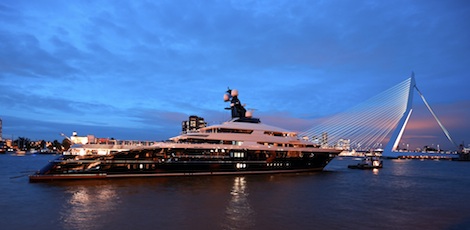‘Equanimity’ relieves itself of PYC compliance just weeks after delivery
Oceanco's 91.5m motoryacht, the first superyacht to be designed and constructed in compliance with the Passenger Yacht Code (PYC), has re-registered as a private vessel, just weeks after delivery as a PYC-compliant yacht.…
A source close to Equanimity revealed that the superyacht was originally being built for an owner with intentions to charter out the vessel, however ownership changed hands late in the build process, with her new owner only wishing to use the yacht privately.
“I don’t think they’re going to hide behind the whole private [registration], because they’ve gone for every certificate under the sun,” the source told SuperyachtNews.com. “They’ve all got Master Mariners on the bridge; you’ve got Class 1s in the engine room. They haven’t tried to shy away. I think it’s just a change. And she’s not going to carry lots of guests; it’s basically just going to be used by the one owner.”
The PYC does impose complicated restrictions when it comes to crewing a vessel, such as the need for crew with an able seaman (AB) ticket. “Generally, commercially you can get four weeks on, four weeks off, whereas you go to a yacht and you’re doing five months on and one month off – there’s absolutely no interest, especially if you’re just cleaning all day,” revealed the source. “Two of the captains came off a large yacht with a number of ABs that followed them, but it’s not the right thing they’re looking for. You’re looking for a deckhand-carpenter, a deckhand-tender driver, rather than an AB ticket. So they’re out there, they’re just not in abundance compared to your normal Yachtmaster.”
AJ Anderson, Wright Maritime Group’s managing director, spoke to SuperyachtNews.com and shed some light on the superyacht industry’s adoption of the PYC. “While yachts are being built to, and operated under, the PYC, the Code is still in the early developmental stage. For its potential or alleged faults, it is a valuable vehicle for yachts to be commercially viable in carrying more than 12 passengers in charter, as well as to perform helicopter operations while in charter.
“In way of construction specification and design we see a number of relatively simple yet critical changes that must be made before we will unequivocally recommend building to the Code to our clients. These changes are easily accomplished and would increase overall efficiency and operational safety. We believe that the MCA [Maritime and Coastguard Agency] will come to a reasonable conclusion if the industry uses its collective persuasion.”
For improved ease of compliance within this industry, Anderson advised the Code’s manning requirements be looked at. “In respect to operational requirements, we suggest that the MCA and REG flags reconsider the manning requirements – in particular to PYC vessels under 3,000gt. As one example, the same -3,000gt/+3,000kW vessel certified under PYC requires three more certified engineering personnel than if it were certified under LY3 [Large Yacht Code]. This might be fine on a larger vessel which would typically have more berths for the additional engineering staff, but on a yacht less than even 3,500gt, space for engineering crew accommodations may conflict with cabin space for hotel and deck staff. That means on yachts less than roughly 4,000gt, the possibility of fewer hotel or deck staff to do an equal amount of work required on the same size yacht certified under LY3,” explained Anderson.
“Like in all the Codes, there are examples of where construction requirements and operational requirements are not in line with a common-sense approach,” Anderson concluded. “The industry should continue to persuade the MCA and REG to make the appropriate changes – now – before the coming review is complete.”
Profile links
NEW: Sign up for SuperyachtNewsweek!
Get the latest weekly news, in-depth reports, intelligence, and strategic insights, delivered directly from The Superyacht Group's editors and market analysts.
Stay at the forefront of the superyacht industry with SuperyachtNewsweek
Click here to become part of The Superyacht Group community, and join us in our mission to make this industry accessible to all, and prosperous for the long-term. We are offering access to the superyacht industry’s most comprehensive and longstanding archive of business-critical information, as well as a comprehensive, real-time superyacht fleet database, for just £10 per month, because we are One Industry with One Mission. Sign up here.
NEW: Sign up for
SuperyachtNewsweek!
Get the latest weekly news, in-depth reports, intelligence, and strategic insights, delivered directly from The Superyacht Group's editors and market analysts.
Stay at the forefront of the superyacht industry with SuperyachtNewsweek




